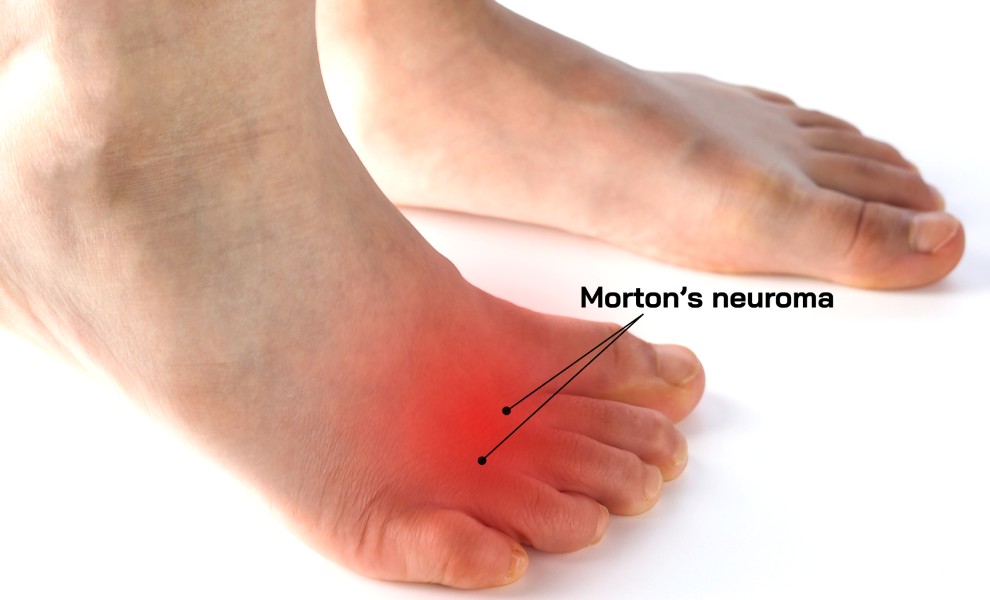Morton’s Neuroma is a common condition that affects the nerves in the foot, specifically the nerve that runs between the third and fourth toes.
The condition occurs when the nerve becomes irritated or compressed, leading to pain, numbness, tingling, and burning sensations in the affected area.
Patients often describe it as a feeling of having a small pebble or a ‘bunched-up sock’ inside the shoe.
Morton’s Neuroma is more common in women and is often associated with wearing high-heeled shoes or shoes with a narrow toe box.
Other factors that may contribute to the development of Morton’s Neuroma include foot deformities, such as bunions or hammer toes, and repetitive high-impact activities like running or jumping.
Anatomy and Morton’s Neuroma
Plantar Nerves
The nerves that carry sensation to the underside of the toes are the medial and lateral plantar nerves. As they approach the interdigital space, they divide into their terminal branches, the plantar digital nerves, which are affected in Morton’s neuroma.
They pass underneath the transverse metatarsal ligaments which hold the metatarsals together, putting them at risk of compression and injury. Along with pain, tingling, burning, and numbness may also occur.
Morton’s Neuroma is also known by other names, including Morton’s metatarsalgia, interdigital neuritis, and palmar neuroma.
It is found to be up to 8 times more common in women than men, and usually occurs in people between the ages of 30 to 60 years.
The frequent site of nerve compression is the third interdigital space (between the 3rd and 4th toes), although the neuroma can also develop in the second interdigital space in some cases.
Morton’s Neuroma Symptoms:
-
- Pain in the ball of your foot, especially between your third and fourth toes
- Numbness or tingling in your toes or the ball of your foot.
- Burning sensation in the ball of your foot.
- Feeling like you have a pebble or small object in your shoe.
- Pain that worsens with activity or when wearing tight-fitting shoes
- Pain that improves with rest or taking off your shoes.
- A popping or clicking sensation in the ball of your foot.
If you are experiencing any of these symptoms, it’s important to see a healthcare provider for an accurate diagnosis and appropriate treatment.
Morton’s Neuroma Test
There are several tests that clinicians may use to diagnose Morton’s Neuroma. These include:
-
- Physical exam: During a physical exam, the clinician may press on the affected area of the foot to check for tenderness, swelling, and other signs of Morton’s Neuroma.
- Mulder’s sign: This test involves squeezing the forefoot with one hand while simultaneously pressing on the affected area with the other hand. If you experience a sharp, shooting pain, it may indicate Morton’s Neuroma.
- X-rays: Can help rule out other foot conditions, such as stress fractures, that may be causing your symptoms.
- MRI: An MRI can provide detailed images of the foot and help identify any nerve or tissue damage.
- Ultrasound: An ultrasound can also help visualize the affected area and identify any nerve or tissue damage.
Morton’s neuroma exercises
Morton’s Neuroma is a condition that affects the nerves in the foot, causing pain and discomfort. While exercises alone cannot cure Morton’s Neuroma, they may help alleviate symptoms and prevent the condition from getting worse.
Here are some exercises that may be helpful:
-
- Toe stretches: Sit down and extend one leg in front of you. Place a towel around the ball of your foot and gently pull back, stretching your toes toward your shin. Hold for 15-30 seconds, then release.
- Calf stretches: Stand facing a wall with your hands on the wall at shoulder height. Step one foot back and press the heel down into the ground. Hold for 15-30 seconds.
- Arch strengthening: Sit down and place a towel under your foot. Scrunch your toes to grip the towel and lift your arch. Hold for 5-10 seconds, then release.
Can Morton’s neuroma cause leg pain?
Morton’s Neuroma is a condition that typically causes pain and discomfort in the ball of the foot, especially between the third and fourth toes. However, in some cases, the pain can radiate to the toes, the arch, or even the leg.
The pain in the leg associated with Morton’s Neuroma is usually described as a shooting pain, tingling, or numbness. This pain can occur because the inflamed nerve in the foot is sending abnormal signals to other parts of the body, including the leg.
Morton’s Neuroma Treatment at home
While Morton’s Neuroma requires professional medical attention, there are some home remedies that may help alleviate the symptoms of the condition.
Here are some things you can try at home:
-
- Rest: Avoid high-impact activities and give your feet plenty of rest
- Ice: Apply ice to the affected area for 20 minutes at a time, several times a day.
- Massage: Gently massage the affected area to help reduce pain and inflammation.
- Change shoes: Wear shoes with a wider toe box and lower heel to help reduce pressure on the affected area.
- Arch support: Consider using shoe inserts or arch supports to help distribute your weight more evenly across your foot.
- Over-the-counter pain relievers: Over-the-counter pain relievers such as ibuprofen may help alleviate pain and reduce inflammation.
- Foot exercises: Toe stretches, calf stretches, and arch strengthening exercises can help improve foot flexibility and reduce the risk of further injury.
It’s important to note that home remedies may not be enough to fully treat Morton’s Neuroma.
If your symptoms persist or worsen, you should consult with a healthcare professional for accurate diagnosis and treatment.
Morton’s neuroma shoes : How to select the correct footwear
Wearing proper shoes can play an important role in managing Morton’s Neuroma symptoms.
Here are some factors to consider when selecting shoes:
-
- Toe box: Look for shoes with a wide and spacious toe box that allows your toes to move freely without being cramped. This can help reduce pressure on the ball of your foot where the neuroma is located.
- Heel height: Avoid high heels or shoes with a heel height greater than two inches. High heels can increase pressure on the forefoot and aggravate Morton’s Neuroma.
- Arch support: Look for shoes with adequate arch support that can help distribute your weight more evenly across your foot.
- Cushioning: Shoes with good cushioning can help reduce shock and pressure on your feet, which can be helpful for managing Morton’s Neuroma symptoms.
Overall, it’s important to find shoes that are comfortable and provide adequate support for your feet.
It’s also a good idea to talk to a healthcare professional or a podiatrist for recommendations on the best shoes for your specific needs.
Mortons Neuroma Injection
Mortons Neuroma injection is a treatment option that involves injecting a local anaesthetic and cortisone injection into the area around the affected nerve. The injection helps to reduce inflammation and relieve pain associated with Morton’s Neuroma.
The procedure is usually performed in a doctor’s office or outpatient clinic, and it typically takes just a few minutes. Here are some things to expect during and after the injection:
-
- The injection site will be cleaned and sterilized, and a local anaesthetic may be used to numb the area.
- The doctor may use an ultrasound to guide the needle to the affected area although imaging is not always required (ultrasound scanning often helps in diagnosis)
- Once the needle is in place, a mixture of local anaesthetic and steroid medication will be injected into the area around the affected nerve.
- You should rest and avoid strenuous activity for the first 24-48 hours after the injection
- It may take several days to a few weeks for the injection to take full effect.
Morton’s Neuroma is common condition and can adversely affect your quality of life. It is easily treatable and hence if you suspect you may have Morton’s Neuroma you are advised to consult a healthcare professional





